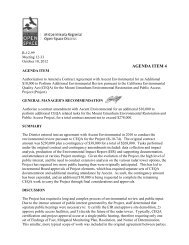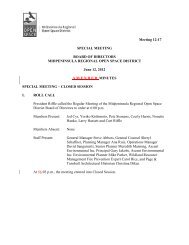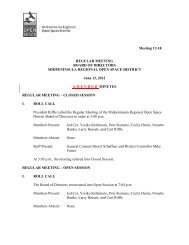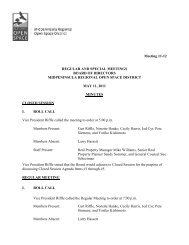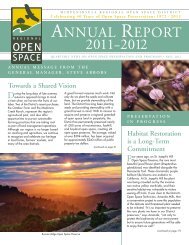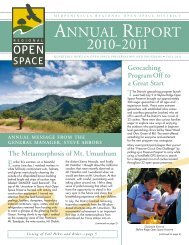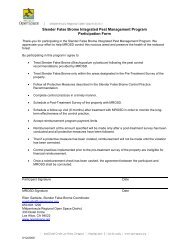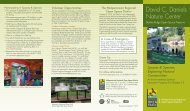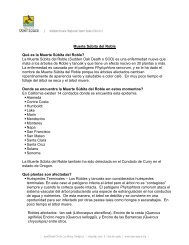Layout 1 (Page 2) - Midpeninsula Regional Open Space District
Layout 1 (Page 2) - Midpeninsula Regional Open Space District
Layout 1 (Page 2) - Midpeninsula Regional Open Space District
You also want an ePaper? Increase the reach of your titles
YUMPU automatically turns print PDFs into web optimized ePapers that Google loves.
MT. UMUNHUM UPDATE<br />
The Latest on the Remediation and Site Planning Projects<br />
Remediation Project<br />
The federally-funded Remediation Project, which will clean up<br />
the contaminants at the former Almaden Air Force Station<br />
at Mt. Umunhum (Sierra Azul <strong>Open</strong> <strong>Space</strong> Preserve), is being<br />
completed by the U.S. Army Corps of Engineers and is moving<br />
along quickly. To date, approximately 30 structures have been<br />
completely abated. The remediation contractor is currently working<br />
inside the radar tower structure. When that work is complete, the<br />
exterior of the radar tower will be cleaned, as well as the exterior<br />
of all other structures on site. We anticipate that all work on site<br />
will be completed by June 2011. This work is the first step in the<br />
remediation project; after removing the hazardous materials,<br />
demolition and restoration work is planned. To see photographs<br />
of the work progress, refer to the project Web site noted at the<br />
end of this article.<br />
Environmental Restoration and Public Access Project<br />
As reported in the spring 2011 edition of <strong>Open</strong> <strong>Space</strong> Views,<br />
the <strong>District</strong> continues its work on the Environmental Restoration<br />
and Public Access Project, which will plan and implement<br />
the site restoration and improvements for public access and<br />
enjoyment of the Mt. Umunhum site.<br />
FIELD NOTES<br />
La Honda Creek<br />
<strong>Open</strong> <strong>Space</strong> Preserve<br />
Pond Restoration Project<br />
In the winter 2010-2011 edition of<br />
<strong>Open</strong> <strong>Space</strong> Views, staff reported that<br />
the pond restoration project at La Honda<br />
Creek <strong>Open</strong> <strong>Space</strong> Preserve, to repair<br />
a failing earthen berm, was successfully<br />
completed. The pond restoration provides<br />
for improved wetland habitat – a deeper,<br />
longer lasting pond and prevention of<br />
sedimentation in downstream Harrington<br />
and San Gregorio Creeks, (which<br />
provides habitat for endangered Coho<br />
salmon and threatened steelhead trout).<br />
The restored pond provides breeding<br />
habitat for the federally threatened<br />
California red-legged frog, a food source<br />
for the federally endangered San Francisco<br />
garter snake, which are found nearby and<br />
with a restored food source, may eventually<br />
colonize the area around the pond. As<br />
part of the restoration efforts, <strong>District</strong><br />
volunteers removed invasive vegetation<br />
surrounding the pond and replaced it<br />
with native wetland plants, including<br />
rushes, sedges, and arroyo willow. Since<br />
frogs typically lay their eggs on this type<br />
of vegetation, restoration planting is a<br />
key final step in habitat enhancement.<br />
Update & Next Steps<br />
The pond filled with winter 2010 rains,<br />
and frogs have already used the restored<br />
pond for their breeding efforts. During<br />
the upcoming months, staff will continue<br />
red-legged frog surveys to determine if<br />
eggs laid in January and February have<br />
developed into frog larvae (or tadpoles).<br />
Staff will monitor the ponds again in<br />
late summer to determine water levels<br />
and to look for frog larvae that have<br />
metamorphosed (or changed into) subadult<br />
* Conservation grazing occurs at La Honda Creek <strong>Open</strong> <strong>Space</strong> Preserve. Cattle can be used as<br />
an effective tool to remove thatch from annual grasses and control invasive, non-native weeds.<br />
15<br />
Project Schedule<br />
Staff is currently preparing the Draft Environmental Impact Report<br />
(DEIR) for the Environmental Restoration and Public Access Project.<br />
Public Release of the DEIR (Public Input Opportunity):<br />
Watch for the public release of the DEIR this summer (anticipated<br />
in June 2011). The DEIR will be available on the <strong>District</strong>’s Web<br />
site for review by the public and the <strong>District</strong>’s Board of Directors.<br />
A 45-day public comment period will follow.<br />
September 2011 – Tentative (Public Input Opportunity):<br />
A Board of Directors public hearing to consider final approval<br />
of the Public Access Plan and CEQA Certification will be held<br />
tentatively in September 2011.<br />
Shortly thereafter, <strong>District</strong> staff will use the project description<br />
analyzed in the Environmental Impact Report to prepare a more<br />
detailed site and implementation plan that will be presented to<br />
the Board of Directors for its consideration. The public will<br />
also have the opportunity to comment at this meeting.<br />
For any questions regarding the Environmental Restoration<br />
and Public Access Project, contact Meredith Manning, Senior<br />
Planner, at 650-691-1200 or mt.um@openspace.org.<br />
To see photographs of the remediation work progress, for more<br />
information on the project goals and objectives, or to review a<br />
copy of the DEIR when released to the public, visit the <strong>District</strong>’s<br />
Web site at: www.openspace.org/plans_projects/<br />
mt_umunhum.asp.<br />
(or juvenile) frogs. These young frogs will<br />
leave the ponds after the first rains and<br />
will return again when they are ready to<br />
begin breeding (usually within 1-2 years).<br />
Monitoring for frogs throughout their life<br />
cycle provides an opportunity for the<br />
<strong>District</strong> to confirm if breeding efforts are<br />
successful each year. Prior to restoration,<br />
the pond dried early each year (May<br />
or June) smothering tadpoles before<br />
they could develop into adult frogs. If<br />
restoration efforts are successful, the<br />
restored pond will provide water long<br />
enough (through August or September)<br />
for frog larvae to fully develop into adult<br />
frogs each year.<br />
This fall, wildlife friendly fencing will<br />
be installed around half of the pond to<br />
exclude cattle* and protect frogs and<br />
egg masses from trampling during their<br />
breeding season. The remainder of the<br />
(continued on page 17)



